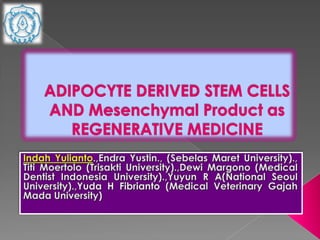Conditioned medium – of adipocyte derived stem cells
- 2.  Ideally, a stem cell for regenerative medicinal applications should meet the following criteria:  Regenerative Medicine :Uses the body’s own stem cells and growth factors is an alternative therapeutic strategy for repair of damage tissue, and becoming predominant cell base therapy
- 3. Regenerative medicinal applications should meet the following criteria: ď‚ž Can be found in abundant quantities (millions to billions of cells) ď‚ž Can be harvested by a minimally invasive procedure ď‚ž Can be differentiated along multiple cell lineage pathways in a regulatable and reproducible manner. ď‚ž Can be safely and effectively transplanted to either an autologous or allogeneic host
- 4. ď‚ž With the increased incidence of obesity in the Indonesia and abroad, subcutaneous adipose tissue is abundant and readily accessible. ď‚ž Approximately 400,000 liposuction surgeries are performed all over the world each year, ď‚ž These procedures yield anywhere from 100 mL to >3 L of lipoaspirate tissue
- 5. Hasil lemak dari liposuction
- 6. pellet
- 7. Adipocyte after 24 hours Adipocyte after 24 hours ADSC pasage 1 : hari ke 3
- 8. A B by dr Indah Yulianto – Yuyun Rindiastuti – Dewi M
- 9. Courtesy by Indah Yulianto – Yuyun Rindiastuti – Dewi M
- 11. ď‚ž ADSCs secrete various growth factors that repair and replace the defective surrounding cells ď‚ž Also a good raw material for skin regeneration, reepithelialization, wound healing and wrinkling care instead of ADSC itself
- 12. ď‚ž
- 13. Oxygen levels & Oxygen sensing, HIF Genetic exogenous stability 1 response oxidative stress Cytogenetic analysis, gene expression, bioenergetics studies Culture grown in -Increase genetic physiologycal 20% instability oxygen -Decrease glycolysis Culture grown in -transcriptional activation standard 3% in HIF 1A target genes oxygen - Inhibition oxygen consumption
- 14. RESULT Growth of hMSC at 20% O2 reduces lifespan, increases oxidative stress and the rate of telomere shortening Cell growth Telomerase shortening & cell senescence
- 15. Growth of hMSC at 20% O2 increases DSB generation and chromosomal instability. DSB level (53BP1 marker) DNA damage & chromosomal aberration
- 16. Exogenous source of ROS cause growth defects & genetic instability
- 18. DISCUSSION -Promotes DNA damage & Culture of senescence mammalian cells -Chromosomal aberration during at 20% oxygen long term culture Importance of biosafety Culture ADMSC at in cell 3% 0xygen therapy Increase growth rate -No evidence of spontaneous immortalization -- reduce telomere shortening rate decrease structural chromosomal aberration
- 19. Significant upregulation of gene Balance expression in cells grown at 3% oxygen bioenergetics tension related to HIF 1A stabilization pattern HIF 1A decreases OXPHOS system by downregulating mitochondrial ATP production & oxygen consumption Autocrine & paracrine effect in cell growth & senescence Implication of gene ontology analysis (HIF 1 dependent gene expression)
- 20. Analysis Method Trypan blue stained cell counted Cell number & by automatic cell counting viability machine (invitrogen) MSC marker CD 44, CD 106 PCR Energy metabolism gene related HIF 1 A, HIF 1B, glycolisis GLUT-1 PCR mechanism Pluripotency HIF 2A, Oct-4, Sox- marker 2, Rex-1 PCR Courtesy by Yuyun Rindiastuti
- 21. RESULT Cell proliferation & viability 5,000,000 4,500,000 4,000,000 3,500,000 Cell number 3,000,000 2,500,000 2,000,000 1,500,000 1,000,000 500,000 0 Graph 1. Cell number profile
- 22. 98% 96% 94% 92% Cell viability 90% 88% 86% Graph 2. Cell viability Courtesy By Yuyun RA
- 24. HIF 1A & GLUT 1 expression Normoxic group Hypoxic group Courtesy By Yuyun RA
- 25. 3 days after skin needling + MCSs + product
- 26. Acne and Acne Scar 1 week After Skin Needling + MCSc + Product
- 28. Acne and Acne Scar 1 week After Skin Needling + MCSs + Product Courtesy by Titik Moertolo
- 35. 1 2 Courtesy by dr Titik Moertolo
- 37. 3 4
- 38. Courtesy by dr Titik Moertolo
- 39. Acne Scar & Box scar 1 week post Dermaroller
- 40. 2 weeks after Skin Needling + Acne Scar before (Box Scar) MShCs Courtesy by dr Titik Moertolo
- 44. 1 month after Mesenchymal product ( Injections and Cream) – Men 74 years old By Indah Yulianto
- 45. 3 weeks after MSCs Product Injections + Cream BY Indah Yulianto
- 46. Bone 1 week after 2 weeks after (painful & sensitivity +) 25 % reduce in 2 weeks
- 47. Luka bakar + infeksi 5 bulan intra kutan produk MShCs y.l. regenerasi Hari ke 15 : penyembuhan 75% tanpa Pengolesan Krem + Produk MShCs Cicatriks ataupun Retraksi persendian
















































